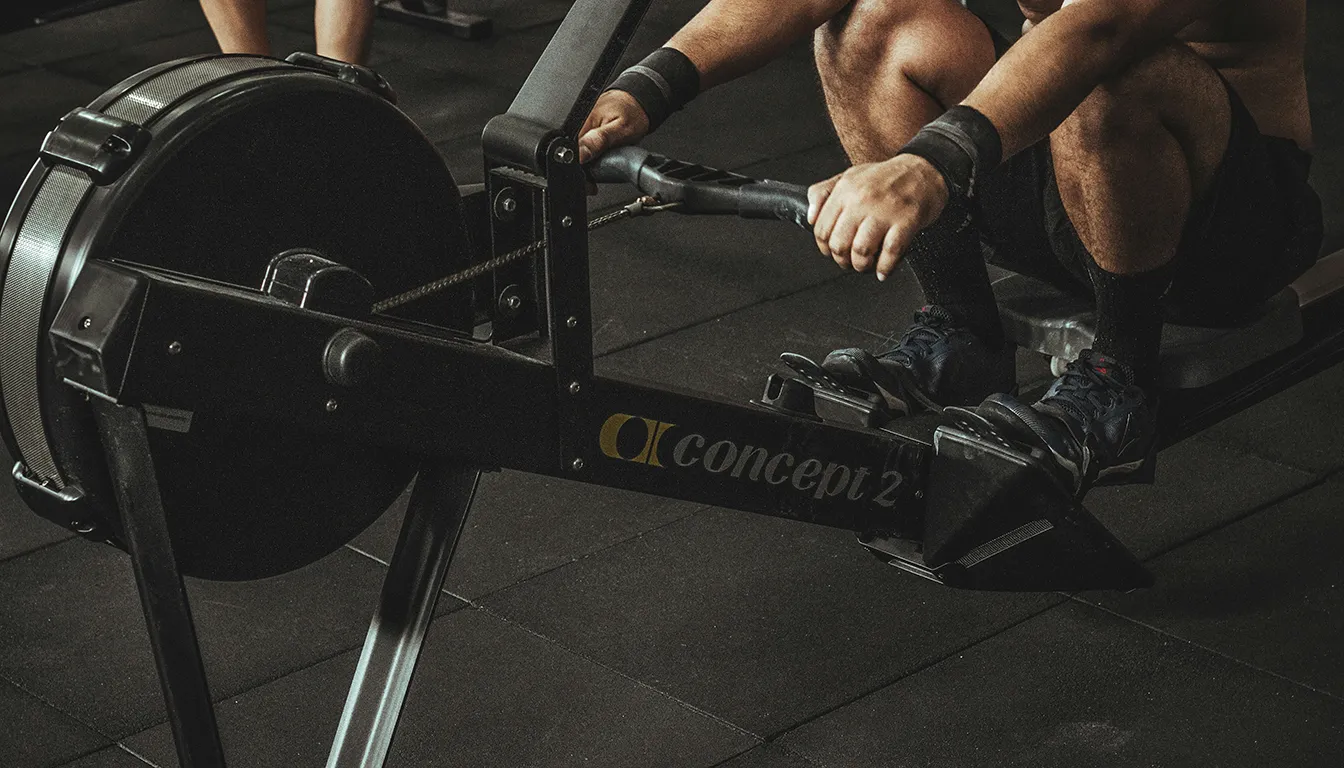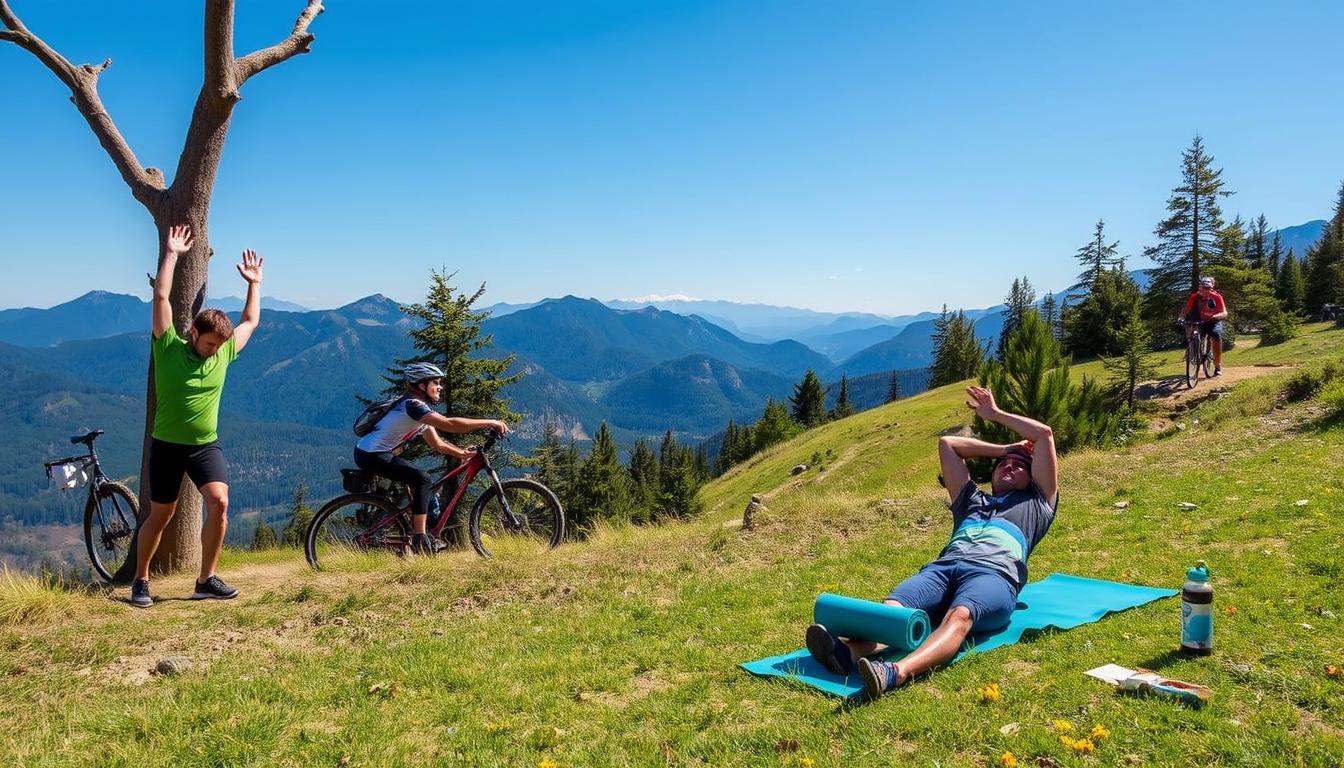Mountain biking needs good physical shape to perform better on trails. Many riders don’t pay enough attention to fitness, but a mix of strength training and endurance can really help. If you’re starting, improve your aerobic fitness and overall strength to ride better.
Try workouts that mix strength exercises twice a week with an aerobic ride. Remember, recovery is key. Get 8-9 hours of sleep, eat 1.5-2 g of protein per kg of body weight, and stay hydrated to boost your fitness.
Being consistent with training is better than doing intense workouts now and then. More time biking in different conditions improves skill and fitness. Working with expert riders or coaches can also help your mountain bike fitness journey.
Understanding the Importance of Mountain Bike Fitness
Being fit for mountain biking brings many plus points. It’s not just about better riding. With more endurance and strength, you can enjoy different trails, including the tough ones. Being fit also means a healthier heart, better breathing, and stronger muscles. This sport is also good for preventing injuries.
The Benefits of Being Fit for Mountain Biking
Physical fitness means better performance on your bike. With more stamina, rides last longer without feeling tired. Strength training helps in climbing and descending, burning lots of calories. It’s a complete workout, helpful for the heart and muscles.
- Enhanced endurance allows for longer rides without fatigue.
- Injury prevention through improved body mechanics leads to a more enjoyable experience.
- Stronger muscles from a fitness regimen enable quicker recovery.
- The rush of mountain biking positively impacts mood and overall mental wellbeing.
Common Fitness Myths in Mountain Biking
Some myths about fitness in cycling still exist. One is that just riding or doing high-intensity workouts is enough. But, a balanced fitness routine, including strength training, is key. It helps in performance and avoiding injuries. Even casual riders gain from a well-rounded approach.
Professional athletes stress on strength training against common cycling myths. Doing resistance exercises improves your biking and breaks the myth that cycling doesn’t offer a full workout. Adding various training techniques enhances your experience.
| Benefit | Description |
|---|---|
| Improved Endurance | Allows longer rides and better stamina on challenging trails. |
| Enhancement of Muscle Strength | Facilitates power during climbs and descents. |
| Heart Health | Strengthens the heart, reduces blood pressure, contributing to overall wellbeing. |
| Mental Wellbeing | Boosts mood and self-esteem through physical activity. |
For those interested in mountain biking’s full benefits, consider exploring more about mountain bike fitness. It’s a path to better health, more friends, and lots of fun on two wheels.
Essential Workouts for Better Riding Performance
To boost your cycling skills, mixing effective workouts into your routine is key. Strength training and aerobic exercises can elevate your ride. Let’s dive into the essential workouts that build endurance and power for cyclists.
Strength Training Exercises for Cyclists
Strength training is vital for better performance on trails. It involves exercises for legs, core, and upper body, such as:
- Walking lunges with twists – These strengthen the legs and improve core stability.
- Ball push-ups – They boost upper body strength and activate the core.
- Deadlifts – Key for building lower body strength.
- Renegade rows – Excellent for back and arm strength, crucial for bike control.
- Side plank drops – Aims at core strength, important for stability and endurance.
In these routines, focusing on the correct form is crucial. It helps prevent injuries and ensures you get the most from your efforts.
The Role of Aerobic Fitness in Mountain Biking
Aerobic fitness is the backbone of mountain biking success. It provides the stamina needed for long rides. By doing low-intensity exercises, cyclists can build endurance without pushing too hard. Long rides that last 2 to 5 hours are especially good for working Type I muscle fibres.
Knowing about heart rate zones helps in training effectively. Mountain biking pros like Mathieu Van Der Poel prove that focusing on longer rides works well. They maintain power over time by keeping the intensity manageable. Using VO2max intervals of 3-4 minutes can also boost oxygen use during intense efforts.
Adding in “over-under” intervals and technique drills enhances both skill and performance. Creating a balanced plan with strength and aerobic training is key. This way, cyclists can enhance performance and endurance across different terrains.
Mountain Bike Fitness: Developing a Training Plan
Making a training plan that fits your needs is key for mountain biking fitness. It’s important to set clear, achievable goals. This helps start your fitness journey on the right foot. The plan should focus on your goals, like getting ready for an event or boosting your riding skills. Adding variety keeps your training fresh and effective.
Setting Realistic Fitness Goals
Starting with realistic fitness goals is your first step. It’s good to break big goals into smaller, easier steps. This makes it less daunting and lets you focus on specifics, like:
- Distance covered during rides
- Elevation gained during climbs
- Technical skills for handling challenging terrain
Using seasonal training blocks is smart. It gives your plan flexibility and adjusts as your needs change. Planning your training around peak summer events guides your focus on necessary skills and fitness.
Incorporating Rest and Recovery in Your Regimen
Recovery is critical for cyclists. It’s all about active recovery and smart rest days to get the most from training. Rest is crucial for fixing and growing muscles. Food and water strategies are vital for keeping your energy up. Building in longer training periods than a week helps keep things balanced and avoids burnout.
Look at this table for a balanced training view:
| Training Element | Benefits |
|---|---|
| Strength Training | Improves power and endurance, particularly effective during winter months. |
| Interval Sessions | Enhances performance through targeted workouts like over/unders and anaerobic repeats. |
| Skill Development | Essential for conquering challenging terrain and improving technique. |
| Rest Days | Facilitates physical recovery and mental rejuvenation. |
Working with experienced coaches can help create a tailored training plan. Personalised plans that play to your strengths help improve your mountain biking. With a focused and comprehensive plan, achieving your fitness goals while preventing injuries is possible.
Practical Tips for Consistent Mountain Bike Training
Keeping up with consistent training schedule is hard, especially when you’re busy. By using smart mountain biking schedule strategies, riders can keep up with their fitness goals. They can manage both life and training. Here are some tips to help find time for training without feeling stressed.
Finding Time for Training in a Busy Schedule
Adding quick, efficient workouts to a tight schedule can make a big difference. Try these ideas:
- Utilise Short Sessions: Go for 30-minute workouts that mix strength and gentle rides. Short strength exercises work well.
- Plan Efficient Endurance Rides: Use your daily commutes or errands as a chance to ride more.
- Be Flexible: Change your training to fit your time. Even short, intense intervals are beneficial.
Engaging with Fellow Riders for Motivation
Joining local mountain biking groups can bring the group cycling motivation you need. Meeting riding buddies builds community. This can make training more accountable and fun.
- Join Mountain Biking Groups: Discover local fitness communities for shared rides, knowledge, and tips.
- Set Group Goals: Training with others boosts motivation and adds a bit of competition.
- Encourage Each Other: Talk about your experiences and goals to keep motivated and on track.
Conclusion
This summary shows how fitness boosts your mountain bike skills. Adding strength and aerobic exercises helps a lot. Your trail skills will get better with a balanced fitness plan. Riding your mountain bike works out different muscles, making your legs strong and glutes toned. It also improves your heart health greatly.
There’s more to mountain biking than just getting fit. It makes you happy by releasing endorphins, which makes you feel good. Doing these exercises lowers stress and makes your mind clear and strong. But remember, mountain biking should always be fun, no matter your goals.
Mountain biking is more than just exercise. It’s about adventure, making friends, and staying fit all at once. Riding 30 kilometres a week can keep your heart healthy and your mind sharp. Keep riding and stay positive, and you’ll see great benefits in your health and biking skills.
FAQ
Why is mountain bike fitness important for riders?
Being fit boosts your performance on mountain trails. It lets riders handle rough terrains confidently. It also means you can bike longer without getting tired, making the sport more enjoyable.
What are common misconceptions about fitness for mountain biking?
Some think just biking or intense workouts are enough. But, mixing strength exercises into your routine is key. This approach not only ups your game but also cuts down the risk of injuries, helping even those who ride just for fun.
What types of exercises should I include in my strength training routine?
Your strength routine should focus on muscles used in cycling. Include moves like walking lunges with twists and ball push-ups. Also, add deadlifts and side plank drops to build power in your legs, core, and upper body.
How does aerobic fitness contribute to mountain biking?
Good aerobic health is crucial for biking. It gives you the endurance for long rides. Keeping to low-intensity rides boosts your stamina without overworking you. This is essential for all cyclists, whether you ride for fun or compete.
How can I set realistic fitness goals for mountain biking?
Start with goals that match what you wish to achieve. This could relate to gearing up for an event or improving your skills on trails. Break big goals into smaller ones for a clear way forward.
What role does rest and recovery play in a training plan?
Rest and recovery are key to getting stronger. They let your body heal and rebuild. Adding good food, plenty of water, and enough sleep to your rest days helps. So does light activity like walking.
How can I fit training into a busy schedule?
Look for mountain biking training tips for the time-poor. Options include short strength workouts and quick endurance practices. This way, you can easily keep up your training without messing up your daily schedule.
How does training with others improve my fitness journey?
Working out with friends or cycling groups adds fun and motivation. It’s a great way to stay committed. Plus, you get to share and learn tips that boost your fitness journey.







